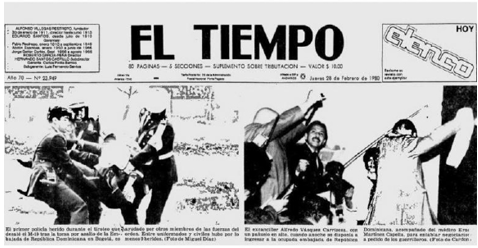doxa.comunicación | nº 27, pp. 99-120 | 115
julio-diciembre de 2018
Juan Carlos Córdoba Laguna
ISSN: 1696-019X / e-ISSN: 2386-3978
information was regularly corrected. Special care was taken to formally deal with the information, which can be interpreted as journalistic responsibility, but also as self-censorship.
Murder of Jaime Garzón August 13, 1999. The fact that Garzón was working for Radio Net at the time was a special component of this incident. He was working alongside renowned journalist Yamid Amat, which created greater mobilisation, greater respect and a great feeling of outrage and indignation for the victim, ten years after the radio coverage of Galàn’s murder, the disorientation and astonishment shown at that time are replaced by an interest in pointing the finger at the perpertrator or perpetrators and the uncertainty of a country that had hit rock bottom.
4.2.2 Written press
Taking of hostages in the Dominican Republic Embassy February 27, 1980. The newspaper El Tiempo constructed a discourse of an us (the country, the institutionality, the Colombians who supported the state) vs. a them, the guerrilla. The president implemented some control measures through a “Security Statute,” which was reported in a positive light in the newspaper.
The events in the Embassy had several dramatic elements, such as the operation which was shot in a cinematographically action-packed way, attracting more than 200 local and foreign journalists that set up a make-shift camp called “Villa Chiva”. The events happened in front of the camera for 61 days, where female guerillas could be seen, as well as party negotiations in a van, rumours of a military operation to take the Embassy back, an ambassador fleeing captivity, and, finally, the departure of the guerrillas and hostages for Havana,
Table 5. The front page of the newspaper El Tiempo February 25, 1980
Photo: Cardona, El Tiempo Archive.
